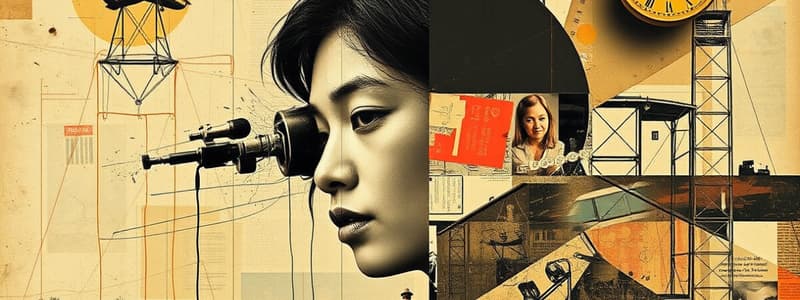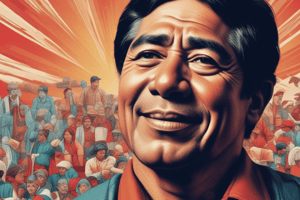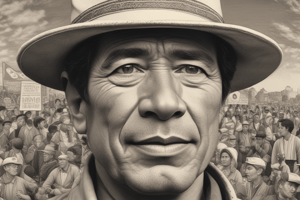Podcast
Questions and Answers
What does the depiction of the man with his hands on his head in the painting symbolize?
What does the depiction of the man with his hands on his head in the painting symbolize?
- Overwhelming pain and confusion (correct)
- A sign of strength and control
- A state of enlightenment
- Joyful expression of life
Which colors are used in the painting to symbolize the Philippines?
Which colors are used in the painting to symbolize the Philippines?
- Green for land and yellow for sunlight
- White for purity and blue for peace
- Brown for land and blue for water (correct)
- Red for danger and black for despair
What is the significance of the man's nude depiction in the artwork?
What is the significance of the man's nude depiction in the artwork?
- To showcase the beauty of the human form
- To emphasize his victories and achievements
- To represent innocence and vulnerability (correct)
- To illustrate societal norms and expectations
How do the geometrical figures in 'Superstition' contribute to the overall message?
How do the geometrical figures in 'Superstition' contribute to the overall message?
What does the upside-down position of the man in the painting suggest?
What does the upside-down position of the man in the painting suggest?
What societal issue does the painting 'Superstition' criticize?
What societal issue does the painting 'Superstition' criticize?
How does the background color scheme of blue and red affect the interpretation of the painting?
How does the background color scheme of blue and red affect the interpretation of the painting?
What overarching message does 'Superstition' convey about personal beliefs?
What overarching message does 'Superstition' convey about personal beliefs?
Flashcards are hidden until you start studying
Study Notes
Superstition by Cesar Legaspi
- Carlos Legaspi is recognized as a founder of Neo-realism in the Philippines.
- The painting "Superstition" features a central character, a troubled man with his hands on his head, expressing pain.
- The man is depicted with a muscular structure, surrounded by thick, curved, and diagonal geometric figures and forms.
- These geometric shapes vary significantly in size, conveying complexity and irregularity.
- The artwork addresses the theme of false faith, highlighting the fear and anxiety associated with superstitions.
- It critiques the tendency of individuals, particularly Filipinos, to rely on superstitions for an easier life, warning of potential dangers.
- The man’s upside-down position suggests he is in a state of agony or distress, symbolized by his bare nudity, representing innocence and blind faith in societal beliefs.
- The painting features contrasting backgrounds: a blue top resembling water or air and a fiery red bottom, symbolizing descent or loss of control.
- The bowed legs of the figure in the upper left corner may signify deviation from correct and rational paths.
- The choice of colors, blue and brown, symbolically represents the Philippines: brown for the islands and blue for surrounding waters.
- The painting reflects societal beliefs and the importance of questioning inherited ideologies rather than passively accepting them.
- "Superstition" is notable for its impactful narrative and artistic execution, serving as a standard for subsequent art movements and a source of national pride.
Studying That Suits You
Use AI to generate personalized quizzes and flashcards to suit your learning preferences.




